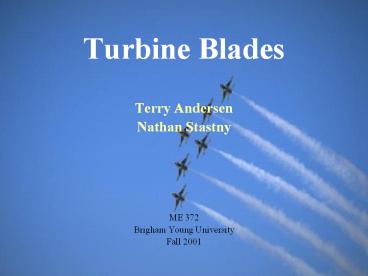Turbine Blades - PowerPoint PPT Presentation
1 / 21
Title: Turbine Blades
1
Turbine Blades
- Terry Andersen
- Nathan Stastny
- ME 372
- Brigham Young University
- Fall 2001
2
Overview
- Applications
- Design Considerations
- Material Considerations
- Manufacturing Processes
- Review
- Questions
3
Applications
- Gas Turbine Generators
- Jet Engines
4
Rolls Royce
Turbine Blades
Rolls Royce Trent
5
Design Considerations
- Geometry
- Cooling Vanes
- Attachment Interface
- Safety Factors
6
Geometry
- Strength / Fatigue Life
- Each row will be different
- Air Flow (CFD Package)
- Machineability
General Turbine Blade Shape
7
Cooling Vanes
- Blades must be kept cool
- Often operate near the metal melting point
- An increase of only 17 ?C can decrease the engine
life by half - Cool (300 ?C ) air is run out of the blades
through small holes (vanes), keeping the blades
from melting.
8
Pic
9
Attachment
- Keep Stress Concentrations Low
- Fir Tree Attachment
- Reduced stress
- concentrations
- Easy replacement
- Also known as the
- Christmas Tree
10
Safety Factors
- Higher S.F. is usually the best.
- But what if the engine runs out of control at
speeds higher than intended? - The energy of the rotating blades goes up with ?2
- What happens if the blades brake at 10 overload?
20, 30, 40, 50 ? - Too much energy and the blades might break
through the engine shroud and into the fuselage.
11
Quick VideoBoeing 777Engine Test
12
Material Considerations
- Environment
- Creep
- Current Materials Used
- Materials In Research
13
Environment
- Air Temperature Between 850 and 1600 C
- Melting Temperature
- Steel1400?C
- Nickel Alloy 1200?C
- Titanium1650?C
- Turbine RPM Appx. 20,000 rpm
14
Creep
- Turbine blades elongate during their life
- Tip clearance
- Result of environment and grain structure
- Soft abradable lining
- Directional solidification (cooling)
- Single crystal structure
15
Current Materials Used
- Initially Steel
- Nickel Alloys
- Most common material is Titanium
- Laser peening
- Ceramic Coatings
16
Material In Research
- Ceramic blades
- Carbon composite blades
- Noise reduction
- Light weight
17
Manufacturing Processes
- Machining (not too common)
- Investment Casting
- Secondary machining
- Electro-Chemical Machining
- Single operation
18
Design Sites
- www.pccsmp.com (manufacturing)
- www.turboblades.com (manufacturing)
- www.giverin.demon.co.uk/NewFiles/HTWTurbines.html
(information) - www.gas-turbines.com/begin (information)
- www.pratt-whitney.com (engine manufacturer)
19
Review
- Applications
- Jet Engines
- Gas Turbine Generators
- Design Factors
- Geometry
- S.F.
- Materials
- Very high temperatures
- Titanium
- Manufacturing
20
Questions
21
Dr. Chase Squadron Commander
Nathan
Terry
Special thanks to all those who didnt believe in
us, but whom weve proved wrong.































